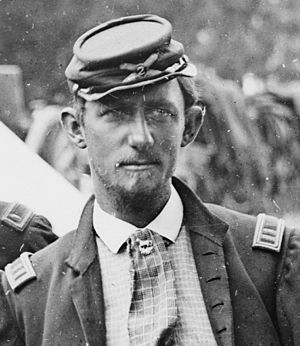Alexander Cummings McWhorter Pennington Jr. facts for kids
Quick facts for kids
Alexander Cummings McWhorter Pennington Jr.
|
|
|---|---|

Alexander C.M. Pennington Jr., 1862. detail of photo by James F. Gibson. Library of Congress
|
|
| Born | January 8, 1838 Newark, New Jersey |
| Died | November 30, 1917 (aged 79) New York City, New York |
| Place of burial |
West Point Cemetery
|
| Allegiance | United States of America Union |
| Service/ |
United States Army Union Army |
| Years of service | 1860–1899 |
| Rank | |
| Commands held | Battery A, 2nd U.S. Artillery Battery M, 2nd U.S. Artillery 3rd New Jersey Volunteer Cavalry 1st Brigade, 3rd Division, Cavalry Corps 2nd U.S. Artillery |
| Battles/wars | American Civil War Spanish–American War |
| Relations | Alexander Cummings McWhorter Pennington (father) |
Alexander Cummings McWhorter Pennington Jr. (born January 8, 1838 – died November 30, 1917) was an important artillery officer and brigadier general in the United States Army. He fought in both the American Civil War and the Spanish–American War.
Contents
Growing Up and Starting His Military Career
Alexander Pennington Jr. was born in Newark, New Jersey. His father, Alexander Cummings McWhorter Pennington, was a Congressman. His family had many important people, including a New Jersey Governor.
He went to the United States Military Academy in West Point. This is a famous school for training army officers. He graduated in 1860. After graduating, he became a second lieutenant in the 2nd U.S. Artillery. This is a type of army unit that uses cannons.
Fighting in the Civil War
Pennington's unit, Battery A, 2nd U.S. Artillery, was special. It was the first unit set up as "horse artillery." This meant their cannons could move quickly with horses. They served with the Army of the Potomac during the American Civil War.
Pennington showed great bravery early in the war during the Peninsula Campaign. He was given special "brevet" promotions for his actions. A brevet promotion means you get a higher rank for bravery, but you don't always get the higher pay right away. He became a brevet captain in 1863 for his actions at Beverly Ford, Virginia. He also became a brevet major for his bravery at the battle of Gettysburg.
Later, he led another artillery unit, Battery M, 2nd U.S. Artillery. In 1864, he became a colonel of the 3rd New Jersey Volunteer Cavalry. He was again honored for his courage at the Battle of Cedar Creek. He led this cavalry unit until the war ended in 1865. For his excellent service, he was promoted to brevet colonel and brevet brigadier general.
After the Wars
After the Civil War, Pennington continued to serve in the regular army. He was a captain in the 1st U.S. Artillery. He then moved to the 4th U.S. Artillery and became a major. Later, he became a lieutenant colonel.
In 1896, he returned to his first regiment, the 2nd U.S. Artillery, and became its colonel and commander. He also commanded Fort Adams in Newport, Rhode Island. This meant he was in charge of all coastal defenses from Maine to Connecticut.
During the Spanish–American War in 1898, Pennington served as a brigadier general of volunteers. He earned his final promotion to brigadier general in the Regular Army just before he retired in 1899.
Pennington retired to New Jersey. He passed away in New York City in 1917 and is buried at West Point Cemetery.
Family
Alexander Pennington and his wife, Clara Miller French Pennington, had at least five children. His daughters, Annie and Edith, married other military officers.

